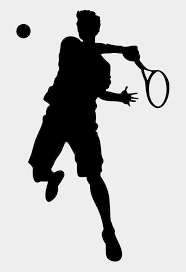Spring/Summer 2021 Featured Research Profile
GU economists hold serve: New research by a team of GCER Fellows and grad students show how Federer, Djokovic, and Nadal can up their game.

Are the world’s best tennis pros playing winning strategies? In their recent paper, “Disequilibrium Play in Tennis” a team of Georgetown faculty and grad students, Axel Anderson, Jeremy Rosen, John Rust, and Kin-Ping Wong, conclude otherwise. They analyze the serve directions of top pros such as Roger Federer, Rafael Nadal, and Nolan Djokovic and conclude that by changing the directions they serve to, these pros can significantly increase their probability of winning the game. For example, they predict that by merely changing serve directions at different stages of the game, Roger Federer could increase his probability of winning the service game when serving to Rafael Nadal from 82% under Federer’s current serve strategy to 89% under the authors’ calculated “best response” serve strategy. For Djokovic serving to Nadal, the authors predict that Djokovic could increase his service game win chance from 84% to 93%.
Tennis serves are made to three key directions: “wide”, “to the body” or “down the T” and these serve directions are recorded for thousands of tennis matches in an online database called the Match Charting Project. The authors analyzed the probability that a given server wins a tennis game conditional on serving to different directions using this database. A key prediction of game theory, von Neumann’s celebrated Minimax Theorem, predicts that if a server randomizes across different serve directions, then the probability of winning conditional on serving to each of the three directions must be the same. The authors’ show that this fails to hold in tennis matches between top pro players, and then use dynamic programming to calculate the chances of winning with an optimal serve strategy given the observed win chances in the data. Even though the increase in the overall probability of winning the tennis game from serving to the direction with the highest win probability is small at any particular stage of the game, a best response strategy that consistently exploits these “one shot deviations” over all possible states in the game of tennis, results in cumulative increase in the probability of winning the overall game at the start of a tennis game that is much more significant, as the numerical predictions shown above indicate.
The size of the estimated increase in win chances contradicts a main prediction of traditional “rational” economic theory, namely that high ability, highly motivated economic agents should behave in accordance with game theory and its prediction that their strategies should constitute a Nash equilibrium. That is, there is no “deviation strategy” that should result in a higher payoff for any of the players in a game. The authors’ analysis suggests one possible explanation for their finding: namely, that professional tennis players have a distorted “mental model” of their own strengths and weaknesses and those of their opponent. The rapidly growing industry of “sports analytics” may help professional tennis players to adopt a more accurate statistical understanding of their own play and those of their opponents, and might ultimately lead to play that is more consistent with the predictions of von Neumanm’s Minimax Theorem, which is a special case (applied to two-person constant sum games) of the more general concept of Nash equilibrium in multiplayer, potentially non-constant sum games.
